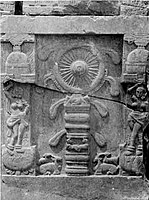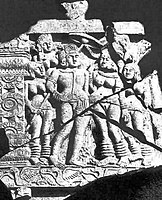Kanaganahalli
Kanaganahalli
Kanganhalli | |
|---|---|
Village | |
| Coordinates: 16°50′08″N 76°55′57″E / 16.835433°N 76.932541°ECoordinates: 16°50′08″N 76°55′57″E / 16.835433°N 76.932541°E | |
| Country | |
| State | Karnataka |
| District | Gulbarga |
| Area | |
| • Total | 1.5 km2 (0.6 sq mi) |
| Languages | |
| • Official | Kannada |
| Time zone | UTC+5:30 (IST) |
| PIN | 585 211 |
| Telephone code | 08474 |
| Nearest city | Chitapur |
Kanaganahalli is about 3 km from Sannati. An important Buddhist site, the place where an ancient Buddhist Mahastupa site found. It is on the left bank of the Bhima river[1] in Chitapur taluk, Gulbarga District in Karnataka, India. Nalwar is the nearest Railway station about 19 km from Kanaganahalli. The Buddhist site about 2.5 km from Chandrala Parameshwari temple of Sannati.
History[edit]
The remains of the excavations site at Kanaganahalli can be dated to between the 1st century BC to the 3rd century AD.
In circa the 1st century BC the stupa at Kanganhalli was constructed, as per the inscriptions referred to as Hama Chaitya and it was patronized by the Hinayana and Mahayana people during the 3rd and 4th centuries AD. During the Shatavahana period, the Amaravati School of art made a deep impact on the sculptural and architectural forms of Kanaganahalli region. This was indeed a period of great artistic efflorescence that gave the Maha chaitya here the most impressive form unsurpassed in the history of stupa architecture in the south India.[2]
The sculptured panels of the medhi are distinctly of native creation. The skill of making two dimensional sculptures and the carving of typical animal motifs are also of indigenous nature. Exhibit a transition phase between the early phase of Amaravati sculptural art and the elaborately sculptured panels of Nagarjunakonda with the sculptural panels found at Kanaganahalli stupa.
The volumes of their improvement over their Amaravati counterparts. The mastery of the artist of Kanganhalli in carving the geometric patterns, floral motifs, dress and ornamentation of the contemporary times and the concept of composition of the subject matter in the large sculptured panels.
The Kanaganahalli Maha Stupa is the veritable gallery of eminent rulers like King Ashoka and the Shatavahana rulers (Simuka, Pulumavi) are immortalized by depicting their portraits at Kanaganahalli.
Unlike the torana of Sanchi, Madhya Pradesh, portrait of emperor Ashoka is said to have depicted there in inscription found at Kanaganahalli.
At Kanganhalli up to the anda portion of the stupa is available, although majority of the architectural members and the sculptural panels are dislodged from the original position.
ASI Excavation Site[edit]

Kanaganahalli is the excavation site of the Archaeological Survey of India.[6]
Excavation during 1994 to 1998[edit]
- During the excavations (1994 to 1998) at Kanaganahalli, found remains of a massive Stupa, many brick structures in the form of a Chaitya-griha and votive stupas were brought to light.
- During the excavations many architectural members of the stupa found like fragments of sculptured veneering slabs, members of railings, pillars, capitals, Buddha padas, sculptures of yaksha and four images of Buddha many more.
- The sculptured panels depicts various Jataka stories and life of Lord Buddha and portrait of many Shatavahana king.
Inscriptions[edit]
In addition to one long inscription, 145 short inscriptions were discovered from the excavations site, dating between 1st century BCE to 1st century CE. The very important discovery was the sculpture of Maurya emperor Ashoka with the label "Rayo Asoka".[7] Kanaganahalli in Karnataka is the site with an inscription in Brahmi script reading "Ranyo Ashoka" (King Ashoka) and a sculpture of King Ashoka.[8] [9]
Excavation during 2000 to 2002[edit]
- During the excavations (2000 to 2002) found bare ruined remnants of a number of brick built structures like paved and sheltered passages connecting them. Also found part of a possible monastic complex to the north west of the main stupa.
- Antiquities such as lead coins bear names of Shatavahana king like Satakarni, Pulumavi and Yajnasri.
- The most important finding of the excavation include a stone sculptured slab bearing the name Raya Ashoka . The first inscribed portrait of Ashoka (surrounded by female attendants and queens) found at Kanaganahalli,[10] was unearthed from the ruined Buddhist stupa.
Satavahana inscriptions[edit]
The oldest Satavahana inscription is the one found on a slab of the upper drum (medhi) of the Kanaganahalli Great Stupa mentioning year 16 of Vasisthiputra Sri Chimuka Satavahana's reign, which can be dated from ca. 110 BCE.[11][12][13][14]
𑀭𑀸𑀚𑀸 𑀲𑀺𑀭𑀺 𑀙𑀺𑀫𑀼𑀓 𑀲𑀸𑀢𑀯𑀸𑀳𑀦𑀲 𑀲𑁄𑀟𑁂 𑀯𑀙𑀭𑁂 𑁛𑁗 𑀫𑀸𑀢𑀺𑀲𑁂𑀓
Rano siri chimu(ka) sātavāhanasa soḍe 10 6 mātiseka
"In the year sixteen 16 of King Siri Chimuka Slilaviihana"
— Kanaganahalli inscription of the 16th year of Simuka.[15]
On another stone slab at Kanaganahalli, the king is possibly shown together with a Nagaraja, and the inscription reads:
𑀭𑀸𑀚𑀸 𑀲𑀺𑀭𑀺 𑀙𑀺𑀫𑀼𑀓𑁄 𑀲𑀸𑀤𑀯𑀸𑀳𑀦𑁄 𑀦𑀸𑀕𑀭𑀸𑀬 𑀲𑀔𑀥𑀸𑀪𑁄
Rājā Siri Chimuko Sādavāhano nāgarāya Sakhadhābho
"Lord King Simuka the Satavahana, Nagaraja Sakhadhābho"— Kanaganahalli inscription of Simuka.[16]
International Buddhist Centre[edit]
An important Buddhist site, Government of Karnataka and ASI Planning to develop Kanaganahalli (and Sannati) as International Buddhist Centre.[17]
Government of Karnataka had constituted Sannati Development Authority and had appointed senior IAS official S.M. Jamdhar as its special officer.
See also[edit]
| Part of a series on |
| Buddhism |
|---|
 |
External links[edit]
- Rediscovering Ashoka, Vithal C Nadkarni, The Times of India, 22 March 2012
- Kanaganahalli - the Buddhist site
- Kanaganahalli Sannati conservation
- Relics of an emperor, LAKSHMI SHARATH, The Hindu, 26 October 2012
- Buddha circuit in Gulbarga
- Photographic documentation of the Kanaganahalli Stupa site - over 1,000 photos by C. Luczanits.
Notes[edit]
- ↑ "GULBARGA DISTRICT". Retrieved 18 February 2009.
- ↑ "Kanganhalli: A unique discovery of Buddhist site in India". Dr. D. Dayalan, Archaeological survey of india. Retrieved 10 May 2009.[permanent dead link]
- ↑ Singh, Upinder (2008). A History of Ancient and Early Medieval India: From the Stone Age to the 12th Century. Pearson Education India. p. 333. ISBN 9788131711200.
- ↑ Singh, Upinder (2017). Political Violence in Ancient India. Harvard University Press. p. 162. ISBN 9780674975279.
- ↑ Thapar, Romila (2012). Aśoka and the Decline of the Mauryas. Oxford University Press. p. 27. ISBN 9780199088683.
- ↑ "Excavations - 2000-2005 - Karnataka". Retrieved 18 February 2009.
- ↑ Michael Meister, "Early Architecture and Its Transformations: New Evidence for Vernacular Origins for the Indian Temple," in The Temple in South Asia, ed. Adam Hardy, London 2007
- ↑ It is not a Rayo Ashoka but Ranyo Ashoka. "A History of Ancient and Early Medieval India: From the Stone Age to the 12th Century" A Book By Upinder Singh.
- ↑ Ranyo Ashoka inscription refer to http://storyofkannada.blogspot.com/2009/12/karnataka-ashoka-s-swarnabhoomi.html?m=1
- ↑ "Rediscovering Ashoka - Kanganhalli". The Times of India. Archived from the original on 9 September 2013. Retrieved 18 June 2013.
- ↑ Ollett, Andrew, (2017). Language of the Snakes: Prakrit, Sanskrit, and the Language Order of Premodern India, University of California Press, Okland, p. 194.
- ↑ Poonacha, K.P., (2013). Excavations at Kanaganahalli, Archaeological Survey of India, Delhi
- ↑ Nakanishi, Maiko, and Oskar von Hinuber, (2014). Kanaganahalli Inscriptions (Supplement to the Annual Report of the International Research Institute for Advanced Buddhology at Soka University for the Academic Year 2013, Vol. 17., Tokyo.
- ↑ Ollett, Andrew (2017). "APPENDIX B: Sātavāhana Inscriptions". Language of the Snakes. University of California Press: 194. JSTOR 10.1525/j.ctt1w8h1vk.14.
- ↑ Zin, Monika (2018). "Kanaganahalli in Satavahana art and Buddhism" (PDF). Journal of the International Association of Buddhist Studies. 41: 540, note 7.
- ↑ "Looking at that one slab from Kanaganahalli (fig. 14), 40 in the upper panel, we see a king. We do not know exactly what the lower part showed because its large part is missing; in any case it is a male person of rank. The label of the inscription reads: rājā Siri Chimuko Sādavāhano nāgarāya Sakhadhābho (?). The inscription lets us believe that it is the historical person of Śrī Simuka founder of the Sātavāhana dynasty who is depicted here, and that he was portrayed on the slab together with a nāgarāja." in Zin, Monika (2012). "The Buddha's Relics and the Nāgas an Attempt to Throw Light on Some Depictions in the Amaravati School". South Asian Archaeology and Art. 2: 763, and fig.14.
- ↑ "Kanaganalli to be developed as International Buddhist Centre". The Hindu. Chennai, India. 22 December 2008. Archived from the original on 3 November 2012. Retrieved 18 February 2009.






